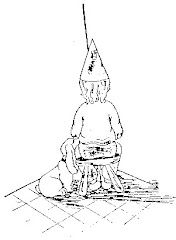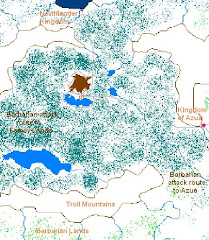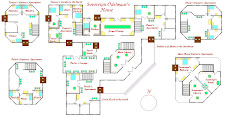Not in the sense the question implies.
Earth is round. It revolves in space as it orbits our sun. The entire surface is accessible to human life - technically. I've never been to the top of Everest, and I don't expect I ever shall.
The worlds of The Great Sea may, or may not be, spherical. But, like icebergs floating in the polar regions, only a portion is visible above the surface of the water. Most of the mass is submerged. And they do not revolve.
The science is difficult - if not downright impossible - to explain because any scientist who has studied more than a few minutes can tell you The Great Sea is not possible in our reality. For it to exist, certain physical laws would have to be altered. Those so grounded in our reality they become annoyed at descriptions which are impossible could never enjoy reading Swords of Fire. In the first place the worlds themselves would tork them off. Next, they would find the concept of flameswords equally impossible. They might accept certain characters popping in and out of Time, but probably not in the way it is done in Swords of Fire.
And yet I claim the light from The Great Sea is visible to Earth.
So how are day and night achieved if worlds do not rotate? How is it that seasons change? Here I am confronted with an exercise in descriptive writing. I must describe something which does not exist in our reality, using only terms from our reality, and have the reader create a working model in their mind. It isn't easy, and I don't expect to be able to achieve it with every reader. Some very famous books do things with their reality which I have trouble envisioning. But here is my go at answering the two questions.
Think of The Great Sea as a giant ring, donut, Cheerio or Fruit Loop, only monstrous in size - galaxy size. (Fruit Loop might be the best example, since so many think of me as being loopy. grin) That is the core. Now consider how it would look if it were 'squished', so that it was no longer a circle, but oval. Now, in the middle space, nearer to one end of the oval than the other, is the 'sun'. And all over the circle, like glaze on a donut, is water. At one time the water was frozen, but now it is free flowing. The water flows 'clockwise', but in a candy stripe course. This means that the water on the inside of the oval flows to the outside of the oval and then back to the inside as it completes the circle. The worlds float on this. While they are in the inside of the oval, the sun is over them and they have day. When they float to the outside, the sun is behind them and they have night. Seasons come and go because some portions of the oval are closer to the sun than others.
To create such a thing in our reality would require a feat of engineering which goes beyond genius. It simply is not the reality God made for us. But there are other realities which we have explored even less than our own.
Consider the vastness of the Universe. We live on one planet, in one solar system, in one galaxy in one universe. There may be other levels I have bypassed. What percentage of the total knowlede of each do we know? I expect the best scientists would admit to a infinitesimally small percentage at the universe and galaxy levels, and perhaps even the solar system. We don't even know everything about what's going on here on Earth. There is so much we do not know about the reality in which we have been placed. This is what excites those scientists who study such things. Their work cannot end in their lifetime. They will always have something new to discover. Good for them! We need their knowledge.
But the size of total knowledge within our own reality is small when compared with what can be known about other realities. I believe God created more realities than this one, and our ability to imagine is our way to tap into them. Remember, God tells us, "with God all things are possible". Now that statement was made specifically in answer to a question about the impossibility of people getting to heaven, but there is no reason not to take the statement literally. Other realities exist, if only in our minds. (One form of insanity is losing the ability to distinguish between realities. This not only makes a person confused, but possibly even dangerous - to others and themselves.)
The easiest place to see this is in the play of children. Their ability (it was once ours, too) to collectively join in imaginative play is more than just cute. During their play they can see the imagined people, creatures, places or what have you - despite it having been imagined by someone else. They work collectively, expanding their temporary reality accordingly.
That's what fiction writing is all about. It is especially so with fantasy and science fiction because those genres frequently include the creation of other worlds. It is one way adults continue their childhood play. All that really matters is that we can return to this reality at will and remember where we are when we do.
Friday, December 26, 2008
Subscribe to:
Post Comments (Atom)
Today's Music
Yeah. That's The Great Sea all right.







No comments:
Post a Comment